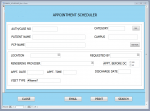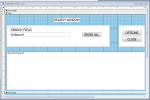Hello all.
I have "some" background in programming, however, not in VBA nor SQL. My database design is not anymore complicated than any other and as I remember in my programming of the past, take each step, baby steps and build upon those baby steps until you have a fully working program.
So with that in mind. I based my database on forms first and a few tables of sample information to get things started and eventually, properly linked.
I have been tracking information in an Excel spreadsheet, not of my design, although I have modified it quite a bit to work in my favor.
To start the design, I walked through my daily process, and even made a word doc with all the steps, no matter how trivial. From there, I created forms that would take place of how I would normally enter into the spreadsheet or write on the printed off "AUTHS" with the patient's info.
Without getting into too much detail of my daily process, I created the forms based on entering said information in a clean layout.
After creating each of the forms, I made search form windows that would pop up whenever I clicked on "search".
What I need to be able to do is:
When I first bring up my "scheduling" form:
How can I first, get the search windows to "search" the master_tbl(excel spreadsheet) to then fill out the "subform" in the main search window(the big white box)?
Then when I double click on any of the entries, it populates all the fields that have information from the spreadsheet, into my simplescheduler_frm.
That's the basic part of it .
.
Any help would be appreciated.
I have gone through so many websites, but nothing specifically answers what I'm looking for and so I have a messy vba right now.:banghead:
I have "some" background in programming, however, not in VBA nor SQL. My database design is not anymore complicated than any other and as I remember in my programming of the past, take each step, baby steps and build upon those baby steps until you have a fully working program.
So with that in mind. I based my database on forms first and a few tables of sample information to get things started and eventually, properly linked.
I have been tracking information in an Excel spreadsheet, not of my design, although I have modified it quite a bit to work in my favor.
To start the design, I walked through my daily process, and even made a word doc with all the steps, no matter how trivial. From there, I created forms that would take place of how I would normally enter into the spreadsheet or write on the printed off "AUTHS" with the patient's info.
Without getting into too much detail of my daily process, I created the forms based on entering said information in a clean layout.
After creating each of the forms, I made search form windows that would pop up whenever I clicked on "search".
What I need to be able to do is:
When I first bring up my "scheduling" form:
- I click on search button. Main search form opens with the option to just enter auth number or detailed search window.
- If I click on detailed button, another search window opens with even more criteria(date of birth, date of appt, auth number, etc.)
How can I first, get the search windows to "search" the master_tbl(excel spreadsheet) to then fill out the "subform" in the main search window(the big white box)?
Then when I double click on any of the entries, it populates all the fields that have information from the spreadsheet, into my simplescheduler_frm.
That's the basic part of it
Any help would be appreciated.
I have gone through so many websites, but nothing specifically answers what I'm looking for and so I have a messy vba right now.:banghead:



